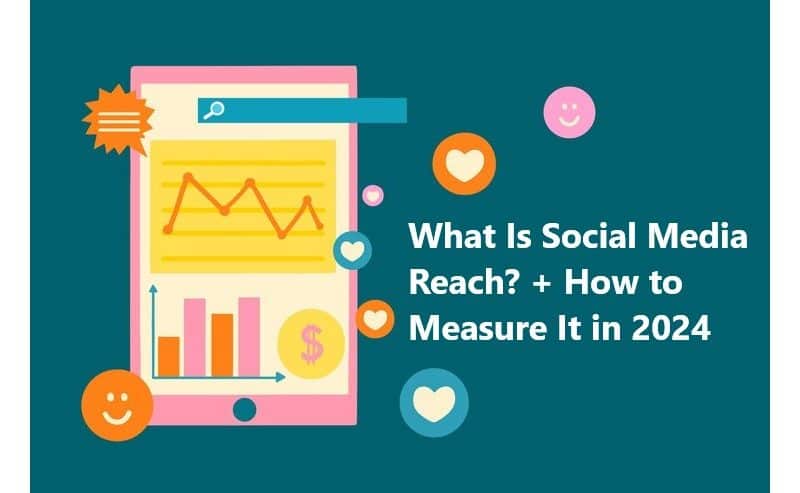You can monitor every aspect of your social media performance with the help of social media metrics. Social media metrics data can give you valuable insights into how your target audience interacts with your brand. One of these metrics for assessing the effectiveness of your social media approach is the social media reach.
In this post, I will show you all you need to know about social media reach, its importance, its types, how to improve it, and how it stacks up against other social media metrics.
Key Points:
- It refers to the total number of unique individuals who have seen a specific post or content on social media, providing insights into the visibility and influence of a brand’s content.
- IMeasuring reach helps businesses assess the effectiveness of their content strategy, identify trends, and optimize for better engagement and platform performance.
- You can use social media analytics tools and native social network insights to track metrics like hashtag performance, audience engagement, and competitor analysis.
- You can improve your organic reach by optimizing your profile, creating evergreen content, engaging with the right audience, using user-generated content, and leveraging live streaming.
- Reach measures the total number of unique users who see your content, while impressions count the total number of times the content is displayed.
What Is Social Media Reach?
Social media reach refers to the total number of distinct individuals or accounts on a social media network that have encountered a specific piece of content. It shows the possible number of people who have seen a message, advertisement, or post. As a crucial indicator of the extent and influence of a post, it shows how widely visible a piece of content is on the platform.
These subjects are among the information that social media reach can provide:
- Achievement of specific campaigns
- The number of active followers
- Effects of collaborations with other brands and influencers
- Online presence outside of social media
- Comparative efficiency of various platforms
- Reaction to and interest in online events
Businesses, influencers, and marketers can assess the success of their online presence and content strategy by looking at social media reach.
What Is The Importance Of Measuring Social Media Reach?
You may evaluate the effectiveness of your social media activities by tracking your social media reach. It offers useful data for evaluating the success of your advertising, content, and overall social media strategy. Knowing your reach will help you make data-driven decisions to maximize your marketing efforts, spot trends, and evaluate the effectiveness of various platforms.
Understanding your social media reach can also help you answer the following:
- How many people can see my brand on social media?
- Which social media platform (X, Facebook, or Instagram) is driving the most engagement and reach for my business?
- Do my social media efforts successfully reach the intended audience?
- How does my reach on social media compare to that of my industry’s rivals?
Finally, understanding your social media reach will help you focus your marketing efforts, choose the right target market, and manage your resources.
Types of Social Media Reach
To measure how effective your social media post is, you must first comprehend the various forms of reach. I will examine each one in turn:
#1. Organic reach:
This is the number of people who view your material without the need for any kind of paid advertising. It’s a fantastic way to measure how naturally your content flows and how interested your audience is.
#2. Paid reach:
This refers to the number of individuals who view your material as a result of sponsored advertisements or promotions. Note that you may increase the visibility of your brand and target particular demographics by investing in paid reach.
#3. Viral reach:
Viral reach calculates the number of individuals who view your social media content as a result of shares and reposts. When your content becomes viral, it takes off on social media platforms and reaches many more people than you could have through paid advertising or organic growth.
How to Measure Social Media Reach?
#1. Social Media Analytics Tools:
To measure your social media reach you’ll need to rely on social media analytics tools. Using a social media analytics tool that offers a dashboard to view your post’s reach across all social networks is the most effective and straightforward way to gauge reach. For instance, Social Media Monitoring Platforms like Hubspot give you a comprehensive overview of your reach across several social media networks from a single, user-friendly dashboard.
Here are some of the popular features of these social media analytics tools:
#1. Hashtag tracking.
You may track hashtag performance connected to your brand, industry, or campaigns with these tools. It is possible to monitor the frequency of usage, reach, and engagement metrics of a hashtag. By doing so, you can better learn the hashtags your audience uses and tailor your content to suit their needs.
#2. Social media listening.
With these social listening tools, you may follow discussions taking place on various social media channels. With just one platform, you can keep an eye on influencers, keywords, and brand mentions and interact with audiences instantly.
#3. Competitor analysis.
You may learn a lot about your competitors’ social media presence using these tools. You can find gaps and seize chances by comparing your brand’s performance to that of your competitors with Profile Analytics.
Read Also: How to Do Competitor Analysis in Digital Marketing: A Step-by-Step Guide
#4. Influencer tracking.
You may learn how each influencer affects the objectives of your social media campaign with the use of influencer analytics. It helps you determine who the best creators are in your field, examine their reach and interaction data, and even evaluate their effectiveness. Note that this aids in your decision-making when working with influencers on your initiatives.
Read Also: How to Leverage Influencer Outreach: Strategies for Brand Growth (+ Templates)
#5. It Offers Real-time analytics and reporting.
With Profile Analytics features, you can see which social media campaigns and postings yielded the best results and which didn’t. This real-time reporting gives you an advantage in optimizing your social media strategy and making data-driven decisions.
Read Also: Social Media Monitoring Platforms: An Expert Guide to Improve Your Engagement
#2. Native social networks:
Direct tracking of your reach data is also possible through each native social media site. For instance, with the “Reach” indicator found under the Insights tab, you can track your Facebook reach.
Note that every social networking site is tracking your account’s “Reach,” but they may be located in various sections of each site.
Read Also: 10 Social Media Analytics to Track on Your Social Media Dashboard
How to Improve Your Organic Social Media Reach
#1. Select the right social media platform.
Businesses and brands can be found on a variety of social media channels these days. However, you should not spend effort when your audience might not be active on every social media platform. Therefore, you may quickly determine which platform is worth your time by using the following methods:
1. Asking your audience directly is the best approach to obtaining precise information about them. With the use of a survey or poll, you can ask them which social media sites they use for personal and professional use while you catch up.
2. Social media platforms and analytics tools offer analytics indicating the individuals who are sharing your post and, more crucially, the locations where they are sharing it. Use these figures to determine which platforms to prioritize.
3. Finally, look at where your competitors are posting. Likely, you shouldn’t be on the platform if you don’t see them anywhere.
Read Also: How to Monitor Competitors in 10 Effective Steps
#2. Optimize your social media profile.
You can adjust every element of your social media profile to increase visibility and optimization. You must be well-versed in these components if you want to be a famous social media brand.
Many of the popular strategies also work here:
- An easily recognizable username
- A well-known image or logo
- Descriptions packed with keywords
- A backlink pointing to your website
Read Also: Digital Marketing Success: 10 SEO Goals Your Brand Should Target for 2024
#3. Create evergreen content
Evergreen content is important and relevant for a long time to create organic social media reach. Long after it was first published, this kind of material still draws readers in, keeps them interested, and consistently adds value.
These posts must be interesting as well. Even if you operate in a dull or uninteresting field, you can still make your posts memorable by incorporating unique content into them.
To create evergreen content, you should:
- Consider solving problems that keep coming up in your industry.
- Posting something amusing and educational. Note that using evergreen content to target feelings like laughter, shock, or amazement is a terrific concept.
- Post positive content more, as they will always receive more shares than negative ones.
#4. Select and interact with the right audience.
Actively interacting with your audience is an integral part of building organic reach on social media. The more active your interactions, the better your organic reach, and this is possible only with the right audience selection.
Therefore, make sure to respond to all the feedback, complaints, and compliments you may receive on your social media pages. In most cases, brands fail to get organic social media reach because their audience selection is flawed. Use social media analytics tools to get insights into your audience and implement your strategies accordingly.
Read Also: My Best Strategies For Audience Engagement With Free Template
#5. Promote user-generated content
Your chances of increasing your organic reach are higher the more individuals are sharing your content. To curate more user-generated content, you should:
Create customized hashtags just for your company. After that, you can request that people who are interested in your business or items post content that includes the campaign hashtag in the photo captions as well.
You can provide prizes for content that features your brand or products and add the content to your feed. Your brand will benefit from increased social media reach as a result of this.
Check out our article on How to Create and Share User-generated Content on Social Media (+ Examples).
#6. Hold live streaming sessions
Content live-streaming can be a highly useful tool for promoting organic reach on social media.
Because they are participatory, live videos greatly increase brand engagement. To master your social media organic strategy, do interactive live streams that compel your audience to respond.
Read Also: Effective Tips for Successful Webinar Marketing: Best Strategies for 2024
#7. Monitor your performance with analytics tools
Social media analytics tools that can help you find valuable information about your content. You can track your interaction and reach on various social media networks with these tools.
With the tool’s assistance, you can monitor all the important data, including which content pieces had the highest interaction and reach. Which ones didn’t?
You may get useful information about your social media activities with our social media analytics tool.
#8. Pay attention to the content you publish.
You can post various kinds of content on all social media platforms, but not all of them can give you the intended audience. Since videos can increase reach and engagement on social media platforms, make sure you concentrate on producing video content.
Furthermore, you can switch between X Spaces and Instagram Reels, and a ton of other content to keep viewers interested. Note that videos are more likely to be shared than other types of content, which is beneficial for boosting organic reach.
#9. Consider the timing of your posts.
When it comes to social media content sharing, timing is everything. For this reason, you should publish content when the majority of your followers are online. By doing this, you can make sure that your content receives the attention it merits, which will broaden its organic social media reach. There are social media analytics tools that can assist you in determining when the majority of your followers are online!
#10. Make use of audience targeting.
You can increase your organic potential by adjusting the settings of your content to specifically target particular audience members. You can control who sees your post on Facebook by using organic post targeting.
You can choose from the following eight Facebook options:
- Gender
- Relationship
- Status
- Education level
- Age
- Location
- Language
- Interests
- Post end date
Read Also: Audience Targeting: What It Is, Why You Need It and Best Tools to Use
#11. Create Interactive Content
Interactive content adds genuine value and increases website traffic. Therefore, your posts will feel more relatable the more interactive and engaging they are.
The most effective methods of involvement are surveys, giveaways, forms, quizzes, and polls. By integrating surveys into your social media content, you can expand your audience. Furthermore, giveaways are a great method to engage your audience and promote your goods.
#12. Be consistent.
The secret to social media success is consistency. You must concentrate on publishing often and at the appropriate periods. The ability to plan and schedule your posts ahead of time makes social media scheduling tools useful. This will assist you in keeping up a strong web presence.
To make sure you are posting regularly and on schedule, keep a content calendar. Planning should always be done with your long-term objectives in mind.
What Is The Difference Between Social Media Reach And Impressions?
The overall number of people who view your material is known as reach. The total number of times your material is shown, whether or not it is clicked, is called an impression.
For example, you post a video on Facebook and have 50 followers. You would have a reach of 50 users and 50 impressions if every follower saw it.
Now if you post two videos to the same followers the following day, and they all see both of them. This means that you have 200 impressions, but your reach remains at 100 users.
What Is The Difference Between Views And Reach?
The number of organic users who have viewed the content in their feed is known as reach. The number of seconds or minutes viewed is called a view. Note that Facebook counts views after three seconds or longer and then counts again after ten seconds.
What Is A Good Social Media Reach Rate?
A good reach can range from 2% to 15%, depending on the kind of content you publish.
How Do I Get Social Media Reach?
The easiest and fastest approach to increasing the number of people who see organic content is to boost it through paid advertising. It offers more control and personalization through complex targeting choices.
What Is An Example Of A Social Media Reach?
An example of social media reach would be if you uploaded a picture on Instagram and 100 different people saw it. In this instance, the post in question would have 100 social media reach. This figure represents the size of the audience that has seen your material.
Is Reach the Same as Impressions?
Social media reach is not the same as impressions. Reach refers to the overall number of people who view your content, while impressions refer to the total number of times your material is shown, whether or not it is clicked.
How to Calculate Social Media Reach?
To calculate the amount of social media reach, you should take the total number of followers divided by the total reach of a post, then multiply the resulting number by 100.
Related Articles:
10 Effective Examples of Clickbait Headlines and Why They Work
What is Brand Monitoring, and Why Is It Important For Your Business?
12+ Social Listening Platforms to Enhance Your Brand Monitoring Strategies
10 Essential Tools for Online Reputation Monitoring: Protecting Your Digital Image






